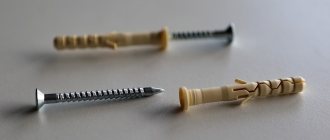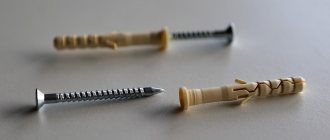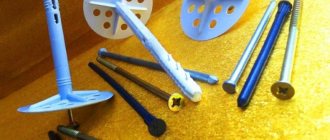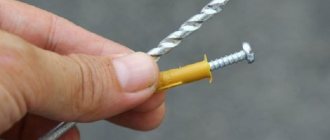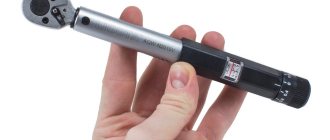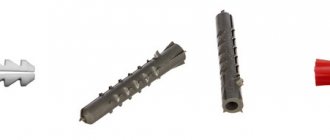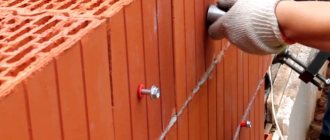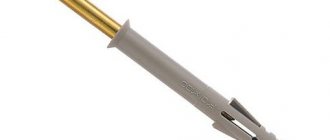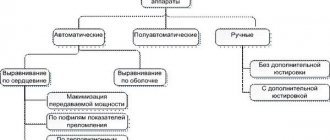The modern dowel-nail replaced wooden dowels, which often split into pieces, dried out and did not adhere well to the load-bearing surface. Composite fasteners with a spacer sleeve significantly speed up most installation work, providing the most reliable fastening of furniture and other products.
What is a dowel-nail?
There is a huge range of fasteners. You need to know what a dowel-nail looks like and understand its varieties in order to choose the best installation method for the job. In the most common version, it is a composite product of two items - a nail and a dowel. When driving the rod, the spacer part expands and is fixed in the surface. The dowel and nail can be made of different materials; more often, depending on the conditions, durable steel or plastic is used.
Description
Nowadays, no repair work can be imagined without the use of dowels. There is always a need to attach something to a wall or ceiling surface. Only if the walls and ceiling are made of wood, you can use nails and a hammer. In all other situations you cannot do without dowel fasteners.
There is a wide range of similar products on sale, differing in the material of manufacture and method of holding. In addition, the weight and size of dowel screws can be very different.
The mounting dowel can be not only polypropylene, but also nylon. The use of the former is possible only in interior decoration, since sub-zero temperatures contribute to the formation of cracks on them. Nylon fasteners are equally suitable for both indoor and outdoor use.
The expansion dowel is used when fastening structures to hollow blocks, concrete and brick. Fixation occurs with the help of special antennae. They securely hold the dowel and prevent it from turning. There are separate types of dowels designed for construction guns. Despite the different installation method, they are quite effective.
Why do you need a dowel-nail?
The main purpose of this product is to securely attach to the load-bearing surface. A dowel-nail for concrete or brick allows you to significantly speed up the pace of work. The presence of a limiting cuff helps not to bury the cap too much into the surface. Nowadays, to fix the slats, it is not necessary to make precise markings. The holes are drilled directly into the plank and the prepared dowel-nails are driven directly through them. The slots on the caps are made to simplify the dismantling of products.
Dowel-nail - characteristics
When preparing for construction work, you need to purchase a lot of consumables. Depending on the type and size, the mounting dowel-nail has different technical characteristics. Let's consider the main parameters of this fastener (minimum and maximum data) using the example of polypropylene products with a hidden side:
- The designation of dowel-nails
is from 6x40 to 10x100. - Do
- hole for dowel (from 6 to 10 mm). - L
– dowel length (from 40 to 100 mm). - Ds
– diameter of nails (from 4 to 7 mm). - Ls
– length of nails (from 42 to 102 mm). - T
– depth of the hole for the dowel-nail for through installation (from 50 to 150 mm). - H
– anchorage depth (from 30 to 50 mm). - Da
– thickness of the attached product (from 10 to 100 mm). - The magnitude of the pulling force (for B25 concrete)
is from 1.6 to 2.4 kN. - The magnitude of the shear force (for B25 concrete)
is from 1.8 to 4.1 kN. - Weight 100 pcs.
dowel-nails - from 3.3 to 15.32 kg.
What is better, a dowel-nail or a dowel-screw?
In both cases, we have products consisting of two elements - a spacer part and a rod (nail, screw). The main difference between a dowel-nail and a dowel-screw is the method of installation in a load-bearing surface. In the first case, you need to drive a nail, and in the version with a screw, the fasteners are screwed in with an electric tool or a screwdriver. Let's consider the advantages and disadvantages of each option.
Dowel nail:
- Installation is faster.
- Suitable for installation in any solid wall except drywall.
- Due to impact loads, the risk of destruction of the front surface increases.
Dowel screw:
- Installation takes longer.
- Dismantling is easy.
- The fastening is considered more reliable.
- Less risk of damage to the façade.
What is better, a dowel-nail or a self-tapping screw?
It is wrong to compare both types of fasteners; they are designed to work in different conditions. A dowel-nail is excellent for brick, concrete, and dense foam block. Screws are recommended for plastic, chipboard or wood. In a pliable material, when screwed in, internal threads are formed that keep the product from being pulled out. If you have to work with metal, durable types of plastic or wood, it is better to use self-tapping screws with a sharp tip or drill.
FACADE AND FRAME EXPANDERS
Polyamide (nylon) expansion dowel for hollow (hollow) materials. Galvanized steel screw with hex head. TSXS
| Designation item mm | Max. thickness of reinforced mm | Drilling diameter mm | Min. fixing depth pcs | Col. in a pack pcs | Mt pull-out force kN | |||
| concrete B 25 | full brick | empty, brick | aerated concrete | |||||
| Т5Х-5 8/100 | 30 | 8 | 70 | 100 | 3.99 | 2.63 | 2.39 | 2.22 |
| Т5Х-510/80 | 30 | 10 | 50 | 50 | 4.01 | 2.63 | 2.39 | 2.22 |
| Т5Х-510/100 | 30 | 10 | 70 | 50 | 4.01 | 2.65 | 2.41 | 2.24 |
| Т5Х-510/120 | 50 | 10 | 70 | 50 | 4.11 | 2.68 | 2.42 | 2.24 |
| Т5Х-510/140 | 70 | 10 | 70 | 50 | 4.22 | 2.70 | 2.43 | 2.21 |
| Т5Х-510/160 | 90 | 10 | 70 | 50 | 4.25 | 2.71 | 2.47 | 2.22 |
| T5X -5 10/200 | 130 | 10 | 70 | 50 | 4.29 | 2.73 | 2.51 | 2.26 |
Types of dowel-nails
Depending on the conditions, builders have to use different tools. For example, attaching an object to a concrete or plasterboard wall has a significant difference. In some cases, the reinforced strength of the rod is important, in other places - thermal conductivity and moisture resistance. Even a seemingly simple driven dowel-nail has several varieties, which differ not only in size and material, but also in the method of installation.
Common types of dowel nails:
- Dowel-nail for manual installation
. - Dowel-nail for a gun
- installation is carried out using an automatic device, which greatly speeds up the progress of work. It does not have a spacer part. The nail is made of the strongest steel (hardness 53-56 HRC, bending no more than 0.1 mm). - Acoustic dowel-nail
- in the manufacture of fasteners, not metal is used, but plastic and fiberglass, which prevents corrosion or the passage of cold. Consumables of this type are used for installation of thermal insulation, sound insulation, cable ducts, and decoration. - Dowel-nail “umbrella”
– has a wide head and a long body, used for fixing thermal insulation.
Plastic dowel nails
A cup made of synthetic material has a spacer and non-spacer surface. The plastic dowel-nail is equipped with a cuff that prevents the fastener from falling into the surface. The presence of toothed elements prevents the product from scrolling in the hole. We list the common types of plastic fasteners:
- Universal dowel
- used together with wood and chipboard screws, screw-screws, suitable for hollow and solid materials. - Expansion dowel S
- nylon fasteners have a double-sided expansion. The absence of a stop edge allows you to hide the dowel inside the plaster. - MS Expansion Dowel
– Suitable for use with standard bolts or threaded rods. - Dowels for aerated concrete GB
– the presence of spiral ribs allows for a very strong fit in soft materials. - Dowels for mounting TV/TVV steps
– have a good surface geometry to prevent creaking and vibration. TV brand fasteners have a small spacer for installation in a steel profile.
Metal dowel nails
The use of a steel spacer sleeve increases the cost of the estimate, but allows you to increase the design load. A metal dowel-nail for foam blocks, brick structures or concrete structures is installed in the same way as plastic fasteners. We list the advantages and disadvantages of this product:
- High load-bearing capacity.
- Metal does not stretch over time.
- The galvanized or stainless steel sleeve is resistant to corrosion.
- Large selection of fasteners.
- Easy installation.
- The cost of dowel-nails made of metal is higher.
- It must be taken into account that steel fasteners can create more stress, so it is better to place them further from the edge.
EXPANSION PLUGS FOR STANDARD KRH FASTENERS
Polyethylene expansion dowel with galvanized steel hook for dense materials.
| Designation | Drilling diameter mm | Hook size OxL mm | Quantity per pack pcs |
| HP 6/44 | 6 | 4.0×44 | 200 |
| HP 8/52 | 8 | 5.0×52 | 200 |
| HP 10/60 | 10 | 6.0×60 | 100 |
| HP 12/80 | 12 | 8.0×80 | 50 |
Polyethylene expansion dowel with galvanized steel half-ring for dense materials.
| Designation | Drilling diameter mm | Hook size per 1mm | Quantity per pack pcs |
| NS 6/65 | 6 | 4.0×65 | 200 |
| NS 8/75 | 8 | 5.0×75 | 100 |
| NS 10/80 | 10 | 6.0×80 | 100 |
| NS 12/80 | 12 | 8.0×80 | 50 |
Polyethylene expansion dowel with galvanized steel closed ring for dense materials.
| Designation | Drilling diameter mm | Hook size OxL mm | Quantity per pack pcs |
| KKN212 | 12 | 8.0×80 | 50 |
How to choose a dowel-nail?
When purchasing consumables, you should take into account their design features. For example, a dowel-nail for insulation has an elongated body to pierce through a block of mineral wool or foam plastic, and a wide head to hold soft material. The shape of the plastic head must meet the mounting conditions. Cone-shaped “sunk” caps are recommended for window frames or wooden beams. When fixing metal brackets, a tighter fit of the cap to the plane is required. Taking into account the type of supporting base, the spacer part of the fastener is selected:
- For a solid base, where anchoring occurs due to friction, a universal dowel-nail is suitable.
- In porous blocks, anchoring is carried out due to the special shape of the sleeve. For example, dowel-nails for aerated concrete have a spiral spacer part.
Dowel-nail - dimensions
Understanding the standard sizes of this fastener is very simple. When choosing a dowel-nail for drywall, foam blocks or brick, you need to know exactly the thickness of the material being attached and the design load. The first number on the marking indicates the outer diameter of the spacer, and the second number indicates its length. For fasteners with polypropylene spacers, the following standard sizes are available:
- 6x40;
- 6x60;
- 6x80;
- 8x60;
- 8x80;
- 8x100;
- 8x120;
- 8x140;
- 10x100.
Dowel nails for an automatic gun have a smaller selection of standard sizes:
- 4.5x30;
- 4.5x40;
- 4.5x50;
- 4.5x60;
- 4.5x80;
- 5x100.
Features of choosing dowels
The most widely available on sale are dowels with a sleeve made of the following types of plastic:
- nylon. Scientifically it is called polyamide (abbreviated as PA). For the production of bushings for fasteners of this type, the following types of raw materials are used: PA-66 and PA-6;
- polypropylene. This material is usually designated by the following sequence of letters: PP;
- polyethylene (hereinafter PE). There are two modifications of this material: LDPE (the abbreviation stands for High Pressure PE) and HDPE (which is Low Pressure PE).
Each type of plastic has its own distinctive properties. Basic information regarding this issue is presented in tabular form.
| Polymer type | Temperature properties | Chemical properties | Interaction with moisture/water | Mechanical qualities |
| PA | Resistant to low temperatures not lower than minus 40°C Tolerates temperature changes well | Does not tolerate contact well with acids H2SO4 and HCl, hydrogen peroxide H2O2 and ozone O3. Resistant to most other acids, as well as alcohols and aggressive alkalis | He drowns in the water. Characterized by a high level of hygroscopicity. Absorbs moisture up to 5 percent of its weight | Brittle at its own low humidity. When this figure is 2%...3%, the material becomes viscous. Fights wear well. Inherent in high strength and the same hardness. |
| PP | Does not tolerate temperatures below 0°C. Demonstrates normal operation at T≤+80°C. Temperature changes are not scary | Does not retain odors. Does not tolerate exposure to chlorine hydrocarbons well. Demonstrates stability upon contact with compounds containing up to several hydroxyls - in other words, with alcohols, solutions of chemically active salts, gasoline, including high-octane gasoline, hydroxides of alkaline earth metals, aggressive acids | Demonstrates low level hygroscopicity | Over time it ages, causing cracks to appear on the PP. It is not prone to breakage. The material is durable and, at the same time, hard. |
| PE | Resistant to temperature changes. Well withstands temperatures T≥-40°C | Does not tolerate contact well with chlorine hydrocarbons and aromatic hydrocarbons. Resistant to high-octane fuel, technical oils, alcohol-containing substances, alkalis and chemically aggressive acids | Resistant to contact with water. Characterized by low hygroscopicity | Also prone to aging and cracking. PE is not brittle, but, on the contrary, a viscous material. Demonstrates good level of strength. |
Analysis of the information presented in the table allows us to formulate a number of recommendations for choosing dowels.
ü Fasteners made from PP and PE should be preferred when indoor work is planned.
ü It is recommended to opt for dowels made of the same materials when high levels of humidity prevail in the room and if contact with an aggressive environment is expected (for example, in food and chemical industry enterprises). But it is necessary to remember the inevitable loss of elasticity and the appearance of a tendency to cracking, which is why it is better not to use parts made from these materials to create highly loaded critical fastenings.
ü PA dowels are suitable for outdoor work: they demonstrate resistance to temperature changes. However, in order to avoid errors during installation, it is necessary to take into account their hygroscopicity, which manifests itself in an increase in the volume of these fasteners. Therefore, it is not recommended to work with PA dowels when the snow melts in the spring or in rainy weather, in other words, when there is high humidity outside.
How to attach a dowel-nail?
Having understood the standard sizes and learned to use an impact drill and hammer drill, it is very easy to install structures using this fastener. The instructions on how to use a dowel-nail are simple:
- Mark the center of the hole.
- We use a puncher to punch a hole of the required diameter, taking into account the markings.
- The length of the hole should be 5-6 mm longer than the dowel used.
- It is advisable to clean the hole from dust with a vacuum cleaner.
- Carefully hammer in the dowel spacer cartridge with a hammer.
- We hammer in a nail, if necessary leaving 2-3 mm for attaching the suspension.
- When fixing brackets or strips, the dowel is inserted from above through the mounting hole in the product.
STEEL PLUGS FOR HOLLOW MATERIALS AND GYPSUM CARDBOARD WALLS MOLLY
| Designation | Drilling diameter mm | Partition thickness mm | Quantity per pack pcs |
| MOLLY 4/21 | 8 | 2-5 | 100 |
| MOLLY 4/32 | 8 | 2-13 | 100 |
| MOLLY 4/38 | 8 | 3-19 | 100 |
| MOLLY 4/46 | 8 | 6-25 | 100 |
| MOLLY 4/54 | 8 | 15-32 | 100 |
| MOLLY 4/59 | 8 | 15-32 | 100 |
| MOLLY 5/37 | 11 | 2-13 | 100 |
| MOLLY 5/52 | 11 | 3-19 | 50 |
| MOLLY 5/65 | 11 | 15-32 | 50 |
| MOLLY 5/80 | 11 | 30-47 | 50 |
| MOLLY 6/37 | 13 | 2-13 | 50 |
| MOLLY 6/52 | 13 | 3-19 | 50 |
| MOLLY 6/65 | 13 | 15-32 | 50 |
| MOLLY 6/80 | 13 | 30-47 | 50 |
| MOLLY 4/32 W/RO/R | 8 | 26-32 | 100 |
| MOLLY 4/38 W/RO/R | 8 | 32-38 | 100 |
| MOLLY 5/52 W/RO/R | 11 | 45-52 | 50 |
| MOLLY 6/52 W/RO/R | 13 | 45-52 | 50 |
How to remove a dowel-nail?
Often, during dismantling, the plastic part becomes firmly stuck in the surface. To pull out a dowel-nail for concrete or other material, craftsmen have invented several tricks:
- We screw the screw into the spacer cup and then use pliers to pull the product out of the wall.
- In serious cases, it is better to use a nail puller instead of pliers.
- If the tip of the screw is broken, you can melt the plastic part enough so that the exposed surface is enough to grip the pliers.
- The metal dowel-nail will first have to be loosened a little in order to be pulled out of the wall.
- If the metal part protrudes very little, then you need to use a hammer drill to make a recess around the head in order to reduce adhesion to the material and free up part of the dowel for a comfortable grip.
Brief historical background
The name of the inventor of the dowel and the date of its invention are unknown. But January 14, 1913 is the day the Englishman John Joseph Rawlings received a patent for this fastener.
The first devices of this kind were made of wood. Today, polyethylene, polypropylene and metal dowels are produced.
In addition, the use of nylon dowels is widespread - their use can solve many problems. These fasteners, complete with screws, are appropriate to use when working with any material.
